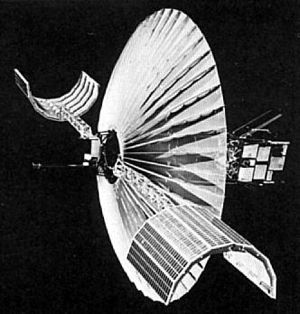
Home - Search - Browse - Alphabetic Index: 0- 1- 2- 3- 4- 5- 6- 7- 8- 9
A- B- C- D- E- F- G- H- I- J- K- L- M- N- O- P- Q- R- S- T- U- V- W- X- Y- Z
ATS-6
 ATS-6 Credit: NASA |
AKA: Applications Technology Satellite. Status: Operational 1974. First Launch: 1974-05-30. Last Launch: 1974-05-30. Number: 1 . Gross mass: 930 kg (2,050 lb). Height: 8.50 m (27.80 ft). Span: 16.00 m (52.00 ft).
During its 5 year life, ATS-6 transmitted educational programming to India, the US and other countries. The vehicle also conducted air traffic control tests, was used to practice satellite-assisted search and rescue techniques, carried an experimental radiometer subsequently carried as a standard instrument aboard weather satellites, and pioneered direct broadcast TV. The satellite also played a major role in the Apollo/Soyuz docking in 1975 when it relayed signals to the Houston Control center.
ATS-6 was boosted above geostationary orbit when thruster failures threatened to prevent further control of the spacecraft. The spacecraft had a 9 m diameter deployed antenna reflector. Pointing accuracy was 0.1 deg. Two half cylinder drum arrays on booms provided 645 W BOL electrical power. The satellite was 3 axis stabilized.
Payloads included the VHRR (Very High Resolution Radiometer) instrument, a millimeter wave propagation experiment, an L-band communications package, and C-band communications equipment
More at: ATS-6.
Family: Communications technology sat, Geosynchronous orbit, Technology. Country: USA. Launch Vehicles: Titan, Titan IIIC. Projects: ATS. Launch Sites: Cape Canaveral, Cape Canaveral LC40. Agency: NASA, NSF, Fairchild. Bibliography: 2, 279, 3572, 3573, 3581, 6, 6371, 12125.
 | ATS 6 Credit: Manufacturer Image |
1974 May 30 - . 13:00 GMT - . Launch Site: Cape Canaveral. Launch Complex: Cape Canaveral LC40. LV Family: Titan. Launch Vehicle: Titan IIIC.
- ATS 6 - .
Payload: ATS F. Mass: 930 kg (2,050 lb). Nation: USA.
Agency: NASA Greenbelt.
Program: ATS.
Class: Technology.
Type: Communications technology satellite. Spacecraft Bus: ATS.
Spacecraft: ATS-6.
Completed Operations Date: 1979-08-02 . USAF Sat Cat: 7318 . COSPAR: 1974-039A. Apogee: 35,444 km (22,023 mi). Perigee: 35,184 km (21,862 mi). Inclination: 13.10 deg. Period: 1,412.00 min.
An Air Force Titan IIIC boosted NASA's Applications Technology Satellite (ATS-F) into orbit from Cape Canaveral. Built by Application Technology Satellite; experimental communications satellite. The purpose of the ATS-6 flight experiment was to demonstrate north-south stationkeeping of a geosynchronous satellite using two cesium ion engine systems. Thruster development tests included a life test of 2614 hours and 471 cycles. Thruster input power was 0.15 kW, which resulted in a thrust of 4.5 mN at a specific impulse of 2500 s. One of the ion engines operated for about one hour and the other for 92 hours. Both of the engines failed to provide thrust on restart due to discharge chamber cesium flooding. The feed system flooding problem caused overloading of the discharge and high voltage power supplies. This failure mechanism was verified through a series of ground tests. However engine operation demonstrated an absence of EMI related to spacecraft systems, verified predictions of spacecraft potential with engines operating, and demonstrated compatibility with the spacecraft's star tracker. It was found that the ion engines or just the neutralizer could discharge large negative spacecraft potentials at all times. Positioned in geosynchronous orbit over the Americas at 94 deg W in 1974-1975; over the Indian Ocean 35 deg E in 1975-1976; over the Americas at 140 deg W in 1976-1979. As of 2 September 2001 located at 172.56 deg W drifting at 6.144 deg E per day. As of 2007 Mar 8 located at 29.12W drifting at 6.125E degrees per day.
Back to top of page
Home - Search - Browse - Alphabetic Index: 0- 1- 2- 3- 4- 5- 6- 7- 8- 9
A- B- C- D- E- F- G- H- I- J- K- L- M- N- O- P- Q- R- S- T- U- V- W- X- Y- Z
© 1997-2019 Mark Wade - Contact
© / Conditions for Use